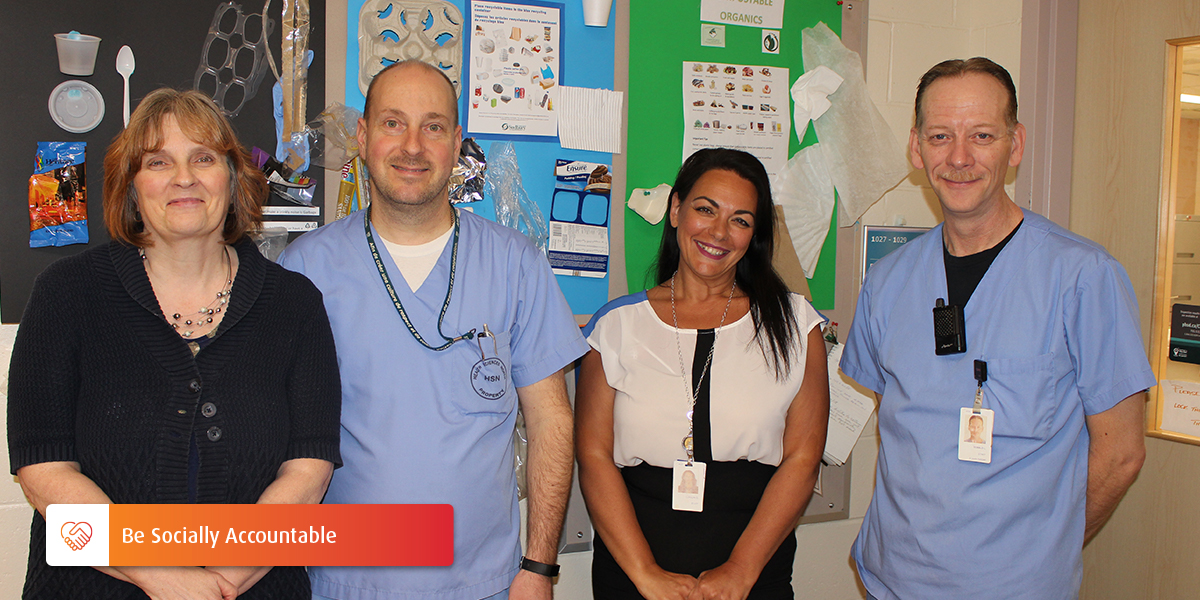HSN Highlights Green Initiatives for Earth Day
April 17, 2019

New compost program and building retrofits helping reduce waste and costs
SUDBURY, ON – As Earth Day (April 22) approaches, Health Sciences North is highlighting a number of environmental initiatives helping to reduce its carbon footprint. Those initiatives include diverting food waste from the landfill and reducing the amount of energy used by the hospital.
In August 2018, HSN began a large scale composting program in the Food Services Department and in the Rock Garden Café. While still in the early stages, the program has been hugely successful, diverting more than 53,500 kilograms of food waste from the local landfill.
“Everything from coffee grinds to apple cores to old paper towel is being sent to the compost instead of into the garbage, this is an easy and effective way to help the planet, and our staff really enjoy it. By doing this, we have been able to divert 25% of our total waste from the landfill.” ~ Kathy Berger, Manager of Support Services, HSN.
The compost program is the latest environmental initiative started at HSN to help the planet. The hospital also has extensive recycling programs across the organization for paper, plastic, e-waste, and medical devices.
Last year, Green Economy North honoured HSN’s Facilities Management Team for implementing a number of successful green initiatives at the hospital, which lead to a reduction in electricity use, and improved air quality. Those initiatives include building retrofits, new LED lighting, and automation, as well as using energy efficient equipment in new construction projects.
“Our goal is to make our facility as energy efficient as possible. Since 2012, we’ve reduced our annual electricity use at the Ramsey Lake Health Centre by approximately 15% or more than 4,380,000 kilowatts,” says Jeff Dunn, HSN’s Manager of Building Services. “To put that into perspective, that’s enough electricity to power approximately 407 homes, annually.”
As part of HSN’s 2019-2024 Strategic Plan, one of the key goals is to be socially accountable. That means the organization will seek and value community engagement and stakeholder participation to address the priority health concerns and health equity gaps for Northerners. This includes doing its part to address climate change.
Going forward, HSN will look to expand current programs, and reduce its carbon footprint, as these initiatives help to provide energy savings which can be reinvested back into patient care.
Fact Sheet
- Compost program begins in August 2018, diverting more than 53,500 kilograms of food waste and paper towel from the local landfill. This represents more than 25% of HSN’s total annual waste.
- HSN’s Facilities Management Team has received recognition from a number of organizations for their green energy initiatives including Green Economy North, the Ontario Hospital Association, Greener Healthcare as well as various external partners.
- Since 2012, Health Sciences North has received over $350,000 in rebates from Greater Sudbury Utilities and Union Gas for energy initiatives.
- In 2017, HSN received over $650,000 in HEEP funding (Hospital Energy Efficiency Program) for energy projects.
- In 2017-2018, HSN recycled more than 8,000 kilograms of e-waste and 170,000 kilograms of recyclable material.
- HSN uses a Daniels Sharps System to dispose of things like needles and razor blades. The use of Sharpsmart system of reusable sharps containers provides a significant reduction in carbon emissions when compared with single-use containers. On a monthly basis, HSN diverts 2000 to 2400 kilograms away from the landfill.
- HSN continues to work with Raw Materials Company since 2013 for free pick up and safe disposal of approximately 8,600 kilograms battery waste, annually
- Materials Management has worked with suppliers to deliver items in reusable totes and reduce the cardboard that enters the facility. Metal is collected for recycling purposes.
- Older beds, desks, carts and other items are stored and redistributed throughout the organization. On occasion, medical beds and equipment are donated to charities and educational institutions. Helping our partners is part of the success of this program